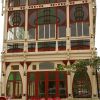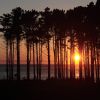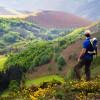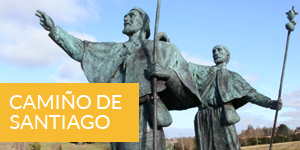- Accede I
- Regístrate I
- carrito
Rías Altas - Costa Ártabra: Mares Legendarios
Duración: 1 día completo
Itinerario: San Andrés de Teixido - Ferrol - A Coruña
Descripción: La Costa Ártabra es el país de los ártabros. Antiguas leyendas de la tradición oral celta que comparte Galicia e Irlanda hablan de Breogán, hijo de Brath, como rey de esta zona y fundador de la ciudad de Brigantia (Art-o Briga), quien habría construido en esa ciudad (la actual A Coruña) una torre o faro que más tarde reconstruyeron los romanos: la Torre de Hércules. El paisaje es una fusión de mar y montaña, con un litoral de bellas playas, unas recogidas, situadas en el seno de las rías, otras salvajes y abiertas al océano. El terreno se va haciendo más difícil, alcanzando al borde del mar alturas superiores a los 500 m, que forman espectaculares acantilados. Es una tierra de miradores naturales, “cruceiros”, bosques, caballos salvajes y leyendas, en donde está el santuario rural más famoso de Galicia: San Andrés de Teixido, destino de una peregrinación ancestral. La última parada de la excursión es la ciudad de A Coruña, con visita, entre otros, al Faro de Hércules.
Paradas recomendadas
San Andrés de Teixido-Ferrol-A Coruña
La excursión discurre dentro de los límites de la provincia de A Coruña, pegada a la costa llamada Ártabra, país de lo ártabros.
Antiguas leyendas de la tradición oral celta que comparte Galicia con Irlanda hablan de Breogán, hijo de Brath, como el rey fundador de la ciudad de Brigantia o Briganza (Art-o Briga), quien habría construido en esa ciudad (la actual A Coruña) una torre o faro que más tarde reconstruyeron los romanos y rebautizaron como Torre de Hércules, donde finaliza esta excursión. Sin embargo Breogán es mucho más que eso: es el padre mítico no sólo de los ártabros, que habitaron estos territorios, sino de toda la nación gallega.
El paisaje de esta zona es una fusión de mar y montaña, con un litoral de numerosas y bellas playas, una serenas y recogidas, situadas en el seno de las rías, otras salvajes, vírgenes y abiertas al océano. El relieve de las sierras de A Faladoira y A Capelada conforma un terreno hermoso pero difícil, que alcanza al borde del mar alturas superiores a los 500 m, formando espectaculares acantilados. Es una tierra de miradores naturales, cruceiros, bosques, caballos salvajes y leyendas, en donde está el santuario rural más famoso de Galicia: San Andrés de Teixido.
La primera etapa de la excursión recorre una ribera sinuosa, rica en paisajes, conformada por los numerosos cursos fluviales que desembocan en esta zona de suaves contrastes, con estuarios, bosques frondosos, villas marineras y reflejos del mar.
Antes de llegar a Cedeira, vemos numerosas y bellas playas como Vilarrube, Pantín y Valdoviño. En las cercanías de esta última se encuentra la Lagoa de Valdoviño. En conjunto, arenal y humedal forman un Espacio Natural en Régimen de Protección General.
Cedeira
Cedeira, o Cetaria, del latín 'cetus' (atún o ballena) es una tranquila villa marinera que no llega a los 8.000 habitantes, con parte antigua de calles estrechas compuestas de pequeñas y lindas casas, algunas con piedras de armas. En el año 1953 fue declarado Municipio de Interés Turístico.
San Andrés de Teixido
Pasada Cedeira, nos dirigimos a San Andrés de Teixido, uno de los lugares de culto y peregrinación más importantes de Galicia.
Cuenta la leyenda que San Andrés, uno de los doce Apóstoles, llegó en barco hasta los acantilados de Teixido. Allí volcó la embarcación y quedó convertida en un peñasco conocido como A Barca de San Andrés. Nadie le prestó ayuda, pero recibió de Dios la promesa de que tendría un santuario y una romería a la que, vivos o muertos, habrían de acudir todos los mortales hasta el fin de los días. De ahí el dicho popular que dice que a San Andrés de Teixido 'vai de morto o que non foi de vivo' (va de muerto el que no fue de vivo).
Se sabe que el monasterio de San Andrés existía ya en el siglo XII, aunque el edificio actual se comenzó a construir en el siglo XVI y se continuó en el XVII y XVIII. Además de la significación religiosa y de la belleza y potencia del paisaje, San Andrés de Teixido es todo un ejemplo del arraigo de tradiciones de origen remoto, como los exvotos colgados de los árboles.
A poca distancia de San Andrés de Teixido está el Mirador de la Garita de Herbeira desde donde hay unas vistas espectaculares del mayor acantilado de Europa: 600 m de caída sobre el mar, con una pendiente superior al 80%.
Ferrol
Una de las siete urbes más importantes de Galicia, y hasta hace unos años también uno de los mayores astilleros de España, Ferrol constituye la ciudad ilustrada de mayor dimensión de Europa realizada sobre el mar. Una ciudad trazada con la razón, marcada por su urbanismo ortogonal, su arquitectura lineal y modernista y la silueta de sus antiguas industrias navales. Pero las construcciones más importantes de Ferrol son, sin duda, el castillo de San Felipe, levantado en la entrada de la ría por Felipe II, y los Arsenales Militares, cuya historia se remonta al año 1749. En torno a ellos se han articulado gran parte de las señas de identidad de la ciudad.
A Coruña
A Coruña es una ciudad rodeada de mar, que parece que va a desprenderse de su istmo para volver a convertirse en la isla que fue hace miles de años. Desde la época romana vivió del comercio marítimo. Sus importantes puertos -comercial, pesquero, y deportivo- hablan de su vocación marina.
Su estupendo paseo marítimo, balcón sobre el océano, la aproxima todavía más al mar. Por él se recorre toda la península y se accede al Parque Celta y al romano Faro de Hércules, el más antiguo del mundo en funcionamiento, símbolo inconfundible de la ciudad y declarado Patrimonio de la Humanidad. También al Museo Arqueológico, situado en el castillo de San Antón, al fabuloso Acuarium, y a la Domus, la Casa del Hombre que, junto con la Casa de las Ciencias, en el parque de Santa Margarita, y el Museo de Bellas Artes, son los pricipales equipamientos culturales y didácticos de una ciudad que presume de una red museística que cuenta también con pequeñas joyas, como el Museo de Arte Sacro, el Museo de los Relojes y la Casa Museo de Emilia Pardo Bazán.
La Marina, con sus casas acristaladas, la calle Real, ideal para las compras, la plaza de María Pita y el sereno casco histórico, de casas de piedra y calles empedradas, donde destacan la Colegiata y la Iglesia de Santiago, son otros tantos atractivos de una ciudad con una gran densidad de población pero también con una gran calidad de vida.
La especial unión de la ciudad con el mar se aprecia con toda claridad desde el monte de San Pedro, mirador privilegiado que en el pasado ocupaban las baterías de costa y que ha sido reconvertido en parque urbano.























